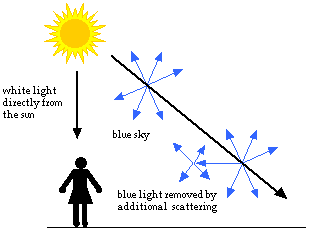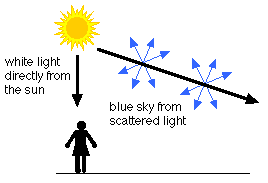The blue color of the sky is due to Rayleigh scattering. As light moves through the atmosphere, most of the longer wavelengths pass straight through. Little of the red, orange and yellow light is affected by the air.
However, much of the shorter wavelength light is absorbed by the gas molecules. The absorbed blue light is then radiated in different directions. It gets scattered all around the sky. Whichever direction you look, some of this scattered blue light reaches you. Since you see the blue light from everywhere overhead, the sky looks blue (left picture).

As you look closer to the horizon, the sky appears much paler in color. To reach you, the scattered blue light must pass through more air. Some of it gets scattered away again in other directions. Less blue light reaches your eyes. The color of the sky near the horizon appears paler or white.
So there you go, that invisible stuff that helps you breath also refracts sunlight. It isn't so crazy if you stop and remember real world experiences like air shaking above pavement on a hot day. Of course a lot of the pretty colors also come from pollutants in the air, as light has to pass through more of these on the horizon as well.
Cheers!
Source
Science Made Simple

No comments:
Post a Comment